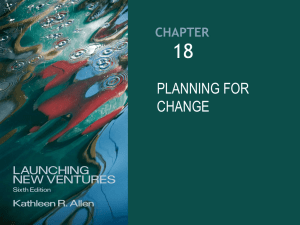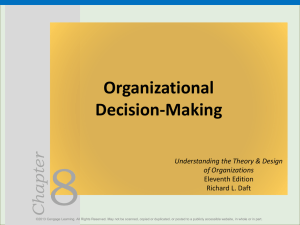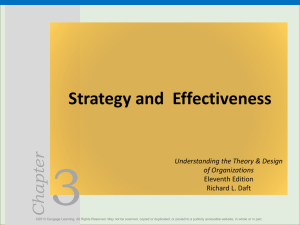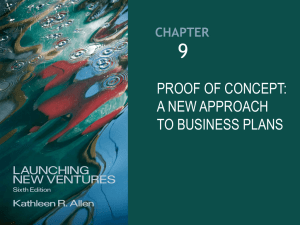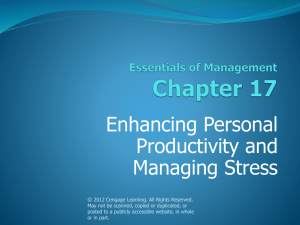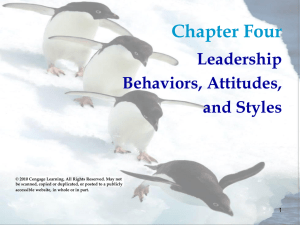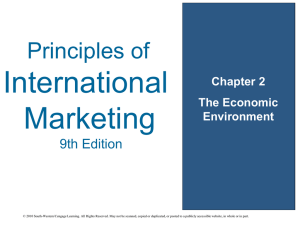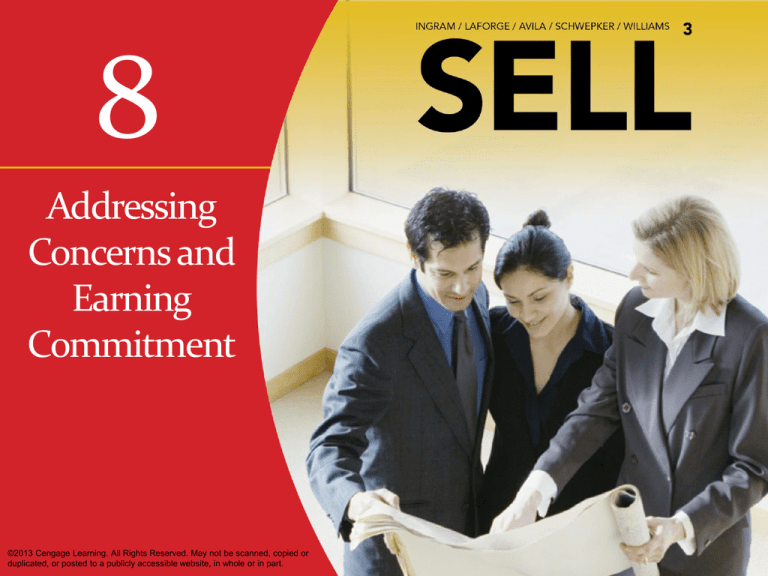
8
Addressing
Concerns and
Earning
Commitment
©2013 Cengage Learning. All Rights Reserved. May not be scanned, copied or
duplicated, or posted to a publicly accessible website, in whole or in part.
Learning Objectives
L 1 Explain why it is important to anticipate
and overcome buyer concerns and
resistance.
L 2 Understand why prospects raise
objections.
L 3 Describe the five major types of sales
resistance.
©2013 Cengage Learning. All Rights Reserved. May not be scanned, copied or duplicated, or posted to a publicly accessible website, in whole or in part.
8
Learning Objectives
L 4 Explain how the LAARC method can be
used to overcome buyer resistance.
the recommended approaches
L 5 Describe
for responding to buyer objections.
L
List and explain the earning commitment
6 techniques that secure commitment and
closing.
©2013 Cengage Learning. All Rights Reserved. May not be scanned, copied or duplicated, or posted to a publicly accessible website, in whole or in part.
8
Key Thoughts
8
• Buyers will raise objections, but if the salesperson did a good job
qualifying the buyer, the resistance shouldn’t be insurmountable.
• Perhaps the most essential component of handling buyer resistance is
listening.
• Buyer’s want to perceive a net gain in value from the exchange
(purchase) before committing to it.
• Making a purchase is inherently risky; finding ways to reduce
perceived risk will increase the probability of
the buyer committing to the purchase.
• The purchase decision is a true test
of the extent to which the buyer
trusts the salesperson.
©2013 Cengage Learning. All Rights Reserved. May not be scanned, copied or duplicated, or posted to a publicly accessible website, in whole or in part.
Objection (Sales Resistance)
Anything the buyer says or does
that slows down or stops the
buying process.
©2013 Cengage Learning. All Rights Reserved. May not be scanned, copied or duplicated, or posted to a publicly accessible website, in whole or in part.
8
Sales Resistance
Buyer’s objections to a
product or service during
a sales presentation.
©2013 Cengage Learning. All Rights Reserved. May not be scanned, copied or duplicated, or posted to a publicly accessible website, in whole or in part.
8
8
Q. 1. Why do prospects raise objections?
©2013 Cengage Learning. All Rights Reserved. May not be scanned, copied or duplicated, or posted to a publicly accessible website, in whole or in part.
Reasons Why
Prospects Raise Objections
• The prospect wants to avoid the sales interview.
• The salesperson has failed to
prospect and qualify properly.
• Objecting is a matter of custom.
• The prospect resists change.
• The prospect fails to
recognize a need.
• Prospect lacks information.
©2013 Cengage Learning. All Rights Reserved. May not be scanned, copied or duplicated, or posted to a publicly accessible website, in whole or in part.
8
Summary of Reasons Why
Prospects Raise Objections
©2013 Cengage Learning. All Rights Reserved. May not be scanned, copied or duplicated, or posted to a publicly accessible website, in whole or in part.
8
8
Q. 2. What are the types of objections?
©2013 Cengage Learning. All Rights Reserved. May not be scanned, copied or duplicated, or posted to a publicly accessible website, in whole or in part.
Major Categories of Objections
No Need
Product or Service Objection
Company Objection
Price is Too High
Time/Delaying
©2013 Cengage Learning. All Rights Reserved. May not be scanned, copied or duplicated, or posted to a publicly accessible website, in whole or in part.
8
Major Categories of Objections
©2013 Cengage Learning. All Rights Reserved. May not be scanned, copied or duplicated, or posted to a publicly accessible website, in whole or in part.
8
Responding to Need Objections
©2013 Cengage Learning. All Rights Reserved. May not be scanned, copied or duplicated, or posted to a publicly accessible website, in whole or in part.
8
Responding to
Product/Service Objections
©2013 Cengage Learning. All Rights Reserved. May not be scanned, copied or duplicated, or posted to a publicly accessible website, in whole or in part.
8
Responding to
Company/Source Objections
©2013 Cengage Learning. All Rights Reserved. May not be scanned, copied or duplicated, or posted to a publicly accessible website, in whole or in part.
8
Responding to Price Objections
©2013 Cengage Learning. All Rights Reserved. May not be scanned, copied or duplicated, or posted to a publicly accessible website, in whole or in part.
8
Responding to Time Objections
©2013 Cengage Learning. All Rights Reserved. May not be scanned, copied or duplicated, or posted to a publicly accessible website, in whole or in part.
8
8
Q. 3. What is the LAARC method of handling
objections?
©2013 Cengage Learning. All Rights Reserved. May not be scanned, copied or duplicated, or posted to a publicly accessible website, in whole or in part.
Handling Buyer Resistance
©2013 Cengage Learning. All Rights Reserved. May not be scanned, copied or duplicated, or posted to a publicly accessible website, in whole or in part.
8
Ethical Dilemma
©2013 Cengage Learning. All Rights Reserved. May not be scanned, copied or duplicated, or posted to a publicly accessible website, in whole or in part.
8
8
Q. 4. What are the other methods of
handling objections?
©2013 Cengage Learning. All Rights Reserved. May not be scanned, copied or duplicated, or posted to a publicly accessible website, in whole or in part.
Other Methods for
Handling Buyer Resistance
• Forestall – Introduce the source of the objection before the prospect
brings it up.
• Direct Denial – A rather harsh response that the prospect is wrong.
• Indirect Denial – Softening the blow when
correcting a prospect’s information.
• Translation or Boomerang – Turn a
reason not to buy (the source of the objection)
into a reason to buy.
• Compensation
– Counterbalance the
objection with an offsetting benefit.
©2013 Cengage Learning. All Rights Reserved. May not be scanned, copied or duplicated, or posted to a publicly accessible website, in whole or in part.
8
Other Methods for
Handling Buyer Resistance
• Question – Ask the buyer assessment questions to gain a better
understanding of the what they are objecting to.
• Third Party Reinforcement – Use the opinion or data from a third
party source to help overcome the objection and
reinforce the salesperson’s points.
• Feel-Felt-Found – Salesperson relates that
others actually found their initial opinions to be
unfounded.
• Coming-to-That – The salesperson tells the
buyer that he or she will be covering the
objection later in his or her presentation.
©2013 Cengage Learning. All Rights Reserved. May not be scanned, copied or duplicated, or posted to a publicly accessible website, in whole or in part.
8
Commitment
©2013 Cengage Learning. All Rights Reserved. May not be scanned, copied or duplicated, or posted to a publicly accessible website, in whole or in part.
8
8
Q. 5. What are the guidelines for earning
commitment?
©2013 Cengage Learning. All Rights Reserved. May not be scanned, copied or duplicated, or posted to a publicly accessible website, in whole or in part.
Guidelines for Earning Commitment
• Look for Commitment Signals
– “That will get the job done”
– “I didn’t realize you delivered everyday.”
– “The price is lower than I thought
it would be.”
• Ask Trial Commitment Questions
– “What do you think about what
we’ve discussed?”
– “Do you see how this will help
your organization?”
©2013 Cengage Learning. All Rights Reserved. May not be scanned, copied or duplicated, or posted to a publicly accessible website, in whole or in part.
8
Guidelines for Earning Commitment
• Resolve “Red Light” Statements Made by
the Prospect
– “I’m not sure that will work."
– “The price is higher than I thought it would be.”
– “Your delivery schedule does not
work for us.”
– “I don’t see the advantage of
going with your proposal.”
©2013 Cengage Learning. All Rights Reserved. May not be scanned, copied or duplicated, or posted to a publicly accessible website, in whole or in part.
8
8
Q. 6. What are the techniques for earning
commitment?
©2013 Cengage Learning. All Rights Reserved. May not be scanned, copied or duplicated, or posted to a publicly accessible website, in whole or in part.
Techniques to Earn Commitment
Success
Story
Balance
Sheet
Legitimate
Choice
Direct
Commitment
Summary
Commitment
©2013 Cengage Learning. All Rights Reserved. May not be scanned, copied or duplicated, or posted to a publicly accessible website, in whole or in part.
8
Techniques to Earn Commitment
©2013 Cengage Learning. All Rights Reserved. May not be scanned, copied or duplicated, or posted to a publicly accessible website, in whole or in part.
8
Techniques to Avoid
©2013 Cengage Learning. All Rights Reserved. May not be scanned, copied or duplicated, or posted to a publicly accessible website, in whole or in part.
8
Ethical Dilemma
©2013 Cengage Learning. All Rights Reserved. May not be scanned, copied or duplicated, or posted to a publicly accessible website, in whole or in part.
8
Dealing with Yes!
• Obtain the customer’s signature
• Provide a plan of action (i.e., answer the
question “now what?”)
• Answer any remaining questions.
• Assure the buyer you will follow-up
• Thank the customer for the business
©2013 Cengage Learning. All Rights Reserved. May not be scanned, copied or duplicated, or posted to a publicly accessible website, in whole or in part.
8
Dealing with No!
•
•
•
•
•
•
Evaluate the customer’s explanation
Maintain the relationship foundation
Understand rejection is a fact of life
Evaluate your performance
Learn from the situation
Make improvements
©2013 Cengage Learning. All Rights Reserved. May not be scanned, copied or duplicated, or posted to a publicly accessible website, in whole or in part.
8

